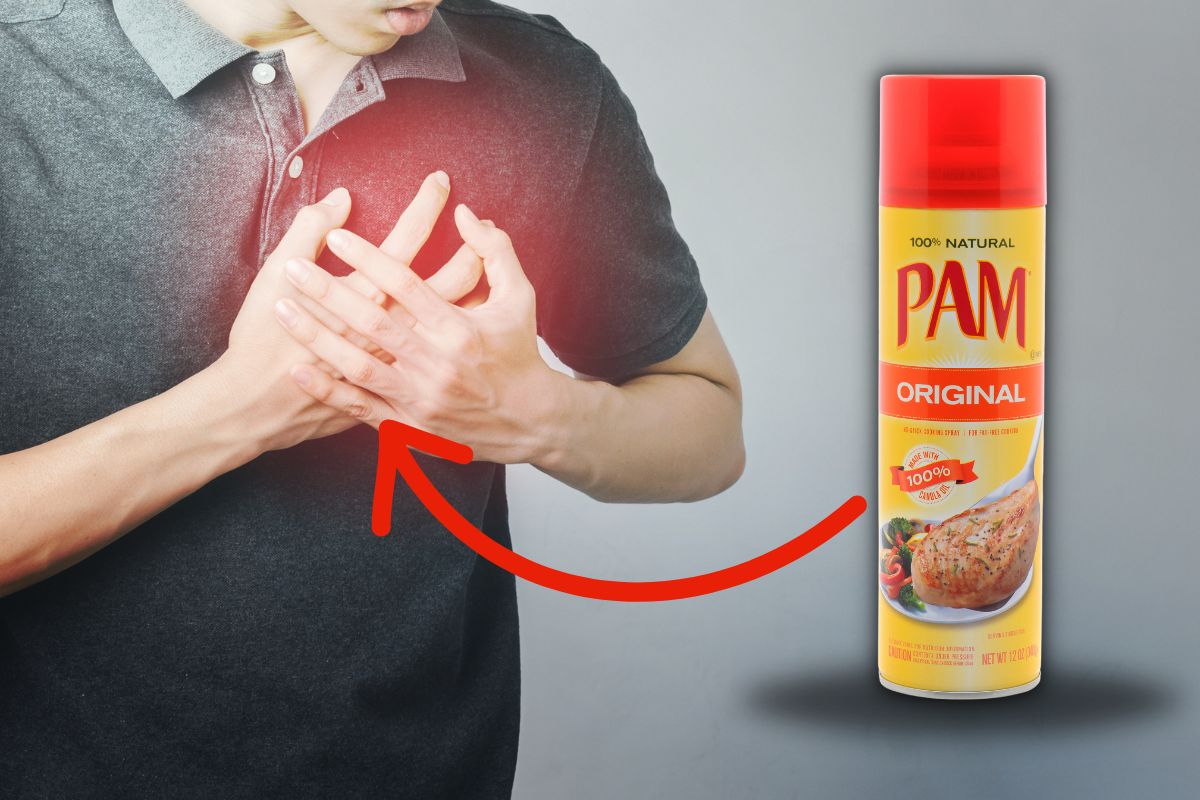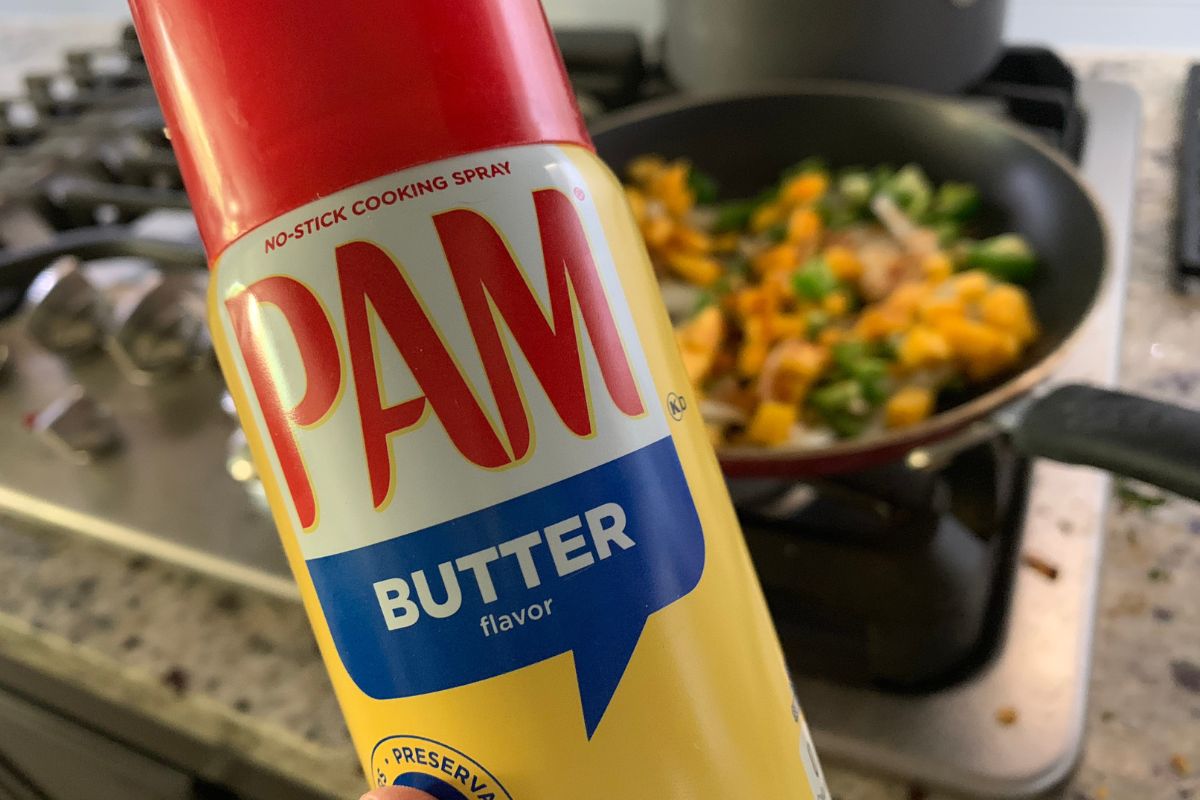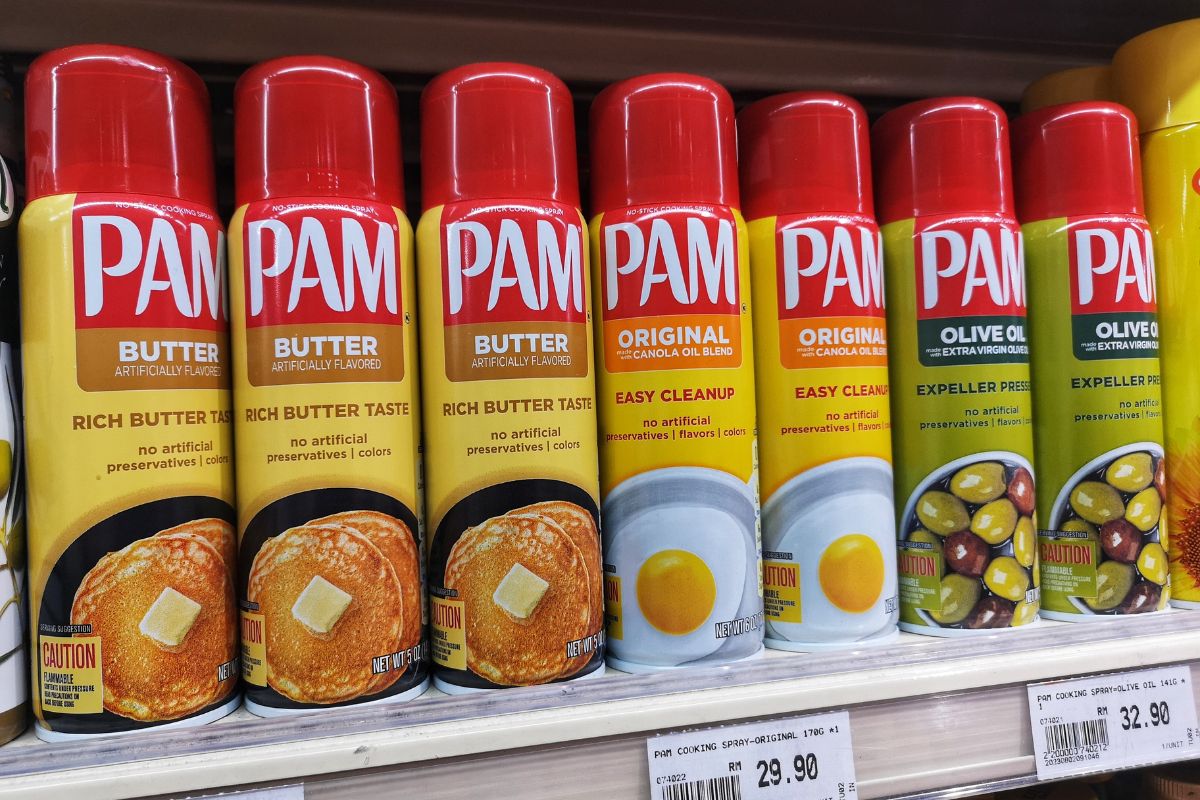PAM cooking spray is a popular product that is designed to replace butter and olive oil to produce an effective, non-stick surface. Over the years, it’s become one of the most popularly used sprays in the world and is likely used by millions of people every day. In fact, it easily leads the market with 145 million annual users (far outpacing the 21 million of Crisco).
But is PAM bad for you? That’s an important thing to answer because so many people use it. You probably never even thought of what’s in it or whether or not the health effects of PAM cooking spray are negative. So, is cooking spray unhealthy and are there PAM cooking spray side effects? Well, that’s what this article about PAM spray is here to find out for you!
In this article about PAM spray, we’ll not only answer the question “Is PAM bad for you?” but also provide more information about the health effects of PAM cooking spray, including PAM cooking spray side effects. If you’ve ever sprayed a pan with PAM and immediately wondered “Is cooking spray unhealthy?” please read on to ensure that you make a smart dietary choice.
Ingredients Analysis
A cooking spray like PAM includes several types of ingredients – a propellant, oils, lecithin, and silicone or additives. We’re going to examine these items below, including what they do, why they’re important, and their potential impact on your health. As we progress further through the article, you’ll understand the question, “Is PAM bad for you?” and learn more about it in general.

Propellant – Isobutane
As the primary propellant in PAM, isobutane is used to push the spray out of the can and apply it to the pan. In most articles about PAM spray, the health effects of PAM cooking spray rarely touch on isobutane. That’s because you typically don’t get much or any of it on the pan. Instead, it mostly floats through the air briefly after you spray PAM on your pan’s surface.
Though mostly considered fairly safe for use in this way, it’s potentially a problem if you inhale it. Isobutane is a type of butane gas and, according to studies, inhaling butane can cause mild to serious lung issues. Some may even feel faint if inhaling too much of it. Now, you’d need to inhale a lot of it to get this effect from PAM, but it’s worth pointing out here.
Oil Types – Canola Oil and Palm Oil
Canola and palm oils help provide the non-stick surface you get from PAM cooking spray. But is cooking spray unhealthy when using ingredients like these? The major concerns over the health effects of PAM cooking spray mostly center on these oils. For example, some studies find that canola oil increases inflammation, affects memory, and could damage heart health.
In the same way, palm oil is an issue because it could increase cholesterol levels, trigger atherosclerosis, and increase your saturated fat levels. That said, both do have potential benefits, with canola oil potentially reducing some heart problems. Moderation is important here, though it’s critical to know these issues before using any PAM in your cooking.

Additives – Lecithin, Dimethyl Silicone, and More
Like any other commercial product, PAM has multiple additives that perform many roles. Many of the concerns about the health effects of Pam cooking spray center on them. But is cooking spray unhealthy? Let’s take a quick look at some of these additives to learn more.
- Soy Lecithin: While generally safe in moderate amounts, soy lecithin may cause soy allergies and digestive problems (stomach aches and diarrhea), particularly for people who are sensitive to soy or who haven’t eaten large amounts of it in many years.
- Dimethyl Silicone: This ingredient is not heavily studied, unfortunately, meaning that its health impacts aren’t well known. As an anti-foaming agent, it keeps PAM from getting too foamy. However, it’s also used in paint, textiles, and even cosmetics – yikes!
- Sorbitan Monostearate: This emulsifier is an important part of PAM cooking spray. Does it cause any Pam cooking spray side effects? While it’s generally safe to eat, it might cause minor digestive issues that could impact some people and make eating very uncomfortable.
Potential Health Risks
PAM cooking spray has little to no nutritional value: just 2.4 calories due to having 0.1 grams of monounsaturated fat and 0.2 milligrams of sodium. But is PAM bad for you? In many an article about PAM spray, you’ll learn about the health effects of PAM cooking spray and the PAM cooking spray side effects. Let’s dive into answering the question “Is cooking spray unhealthy?”
Inhalation Risks
Inhaling too much PAM can cause a weird “high” that’s triggered by the gas and ingredients in the spray. This reaction will vary depending on the person and how much is inhaled. It’s typically not that dangerous unless someone is deliberately trying to use them to get high.
Unfortunately, inhaling aerosol sprays like PAM could cause lower blood oxygen levels in the brain, which could lead to long-term health issues. Even casual use could be a problem without properly aerating the room and ensuring that there’s room to breathe easily.
Respiratory Effects
PAM’s many chemical ingredients could cause a real danger when inhaled. While few people are actively inhaling PAM, its chemical residue does linger in the air after spraying. For example, it contains isobutane and other types of GMOs that could be harmful to the lungs when inhaled.
While there don’t appear to be any studies on the inhalation risks of PAM, some of its additives are troubling. If you’re concerned about them, it’s probably best to stop using PAM, especially if you already have lung troubles or are worried about worsening your health.
But what about lung cancer? Things like propane, butane, and other PAM propellants have been shown to trigger lung cancer. That said, studies about PAM and lung cancer are not readily available. The potentially carcinogenic ingredients are also negligible; the jury is still out here.
Cardiovascular Health
Examining PAM’s nutritional values might make it tempting to spray as much on the pan as you want. However, many articles about PAM spray have highlighted negative cardiovascular health effects of cooking spray and PAM cooking spray side effects on the heart due to heavy use.
How is that possible, and is PAM bad for you and your heart? When used in low levels, probably not – a quick spray on a pan probably causes little issues. But coating a can adds a lot of fat to your food, more than you might think. So, is cooking spray unhealthy for your heart? Potentially.
Usage Guidelines
Now that we’ve answered the question “Is PAM bad for you?” it’s important to know ways you can avoid the health effects of PAM cooking spray. When used properly, cooking spray like PAM is mostly safe. PAM cooking spray side effects are at their worst when using it poorly. So, is cooking spray unhealthy? Not if you stick with these guidelines and find ways to limit your usage.
Recommended Serving Sizes
When using PAM cooking oil, it’s important to follow the guidelines set by the manufacturer. Point the red spray nozzle at the pan before shaking it well and holding the pan about six inches from the spray. Holding it in this way minimizes overuse and ensures that your usage is as safe as possible.
Now, make sure that you only spray for a second or two to lightly coat the bottom of the pan. You don’t need a thick coating or even every inch of the pan covered. Instead, just give it a pass or two to give it the surface coverage it needs to safely and effectively cook your food.
Cooking Temperatures
It’s important to avoid exposing PAM cooking spray to heats over 200-250 degrees Fahrenheit. That’s because the oils in the spray have a low smoke point. Once your spray hits temperatures above 250 degrees, it’s likely to start burning and may even smoke – which is a definite cancer risk.
Pay close attention to your food temperature while you’re cooking, and try to avoid using PAM on any foods that need high temperatures. While there are oven-ready PAM sprays, they’re not necessary because you can use other, safer ingredients and oils to help your food cook properly.
Avoiding Overuse
You don’t necessarily need to use PAM with everything you cook. In fact, adding it to too many foods can affect their overall nutritional value. For example, frying or grilling chicken on a PAM-coated pan may increase its fat and calorie levels and cause other concerns that it’s best to simply avoid.
Here’s a quick way to limit your PAM cooking spray use: ask if you really need to use it at all. Is there an alternative that you can use instead, or is cooking spray unnecessary? Use cooking spray only when it makes sense to ensure that you’re not overdoing it or exposing yourself unnecessarily to danger.
Alternatives to PAM Cooking Spray
If you’re looking to cut PAM cooking spray out of your routine, it’s important to find alternatives. Thankfully, there are many healthy alternatives that can keep you and your family safe. Many even provide unique advantages to your body and mind. Here are three you might enjoy.
Olive Oil Sprayers
An olive oil sprayer carefully distributes a healthy amount of this cooking oil to your surfaces. Instead of using a gas-fueled propellent, it uses a snout that lets you easily control your serving size. The lack of gas also cuts out many of the problematic gasses common with PAM usage.
Coconut Oil
Coconut oil is an increasingly popular cooking oil that provides healthy fats, medium-chain triglycerides, and lauric acid, and might even help with weight loss and brain function. Even better, swilling some in your mouth could fight back against oral bacteria and decay.
Avocado Oil
Avocado oil is another great PAM alternative that works well for many situations. Its high smoke point makes it great for high-temperature cooking, while its design also helps support gut, heart, cholesterol, hair, skin, and eye health. Not bad for such a simple little oil!
